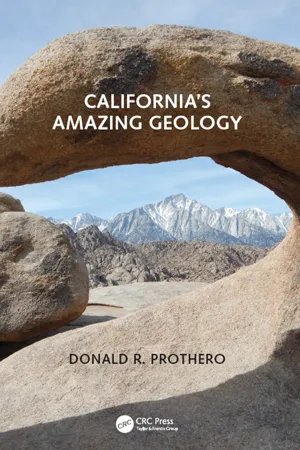
- 480 pages
- English
- ePUB (mobile friendly)
- Available on iOS & Android
California's Amazing Geology
Donald R. Prothero
About This Book
California has some of the most distinctive and unique geology in the United States. It is the only state with all three types of plate boundaries, an extraordinary history of earthquakes and volcanoes, and it has many rocks and minerals found nowhere else. The Golden State includes both the highest and lowest point in the continental US and practically every conceivable geological feature known. This book discusses not only the important geologic features of each region in California, but also the complex geologic four-dimensional puzzle of how California was assembled, beginning over 2 billion years ago. The author provides up-to-date and authoritative review of the geology and geomorphology of each geologic province, as well as recent revelations of tectonic history of California's past. There are separate chapters on some of California's distinctive geologic resources, including gold, oil, water, coastlines, and fossils. An introductory section describes basic rock and mineral types and fundamental aspects of plate tectonics, so that students and other readers can make sense of the bizarre, wild, and crazy jigsaw puzzle that is California's geological history.
Frequently asked questions
Information
Table of contents
- Cover
- Half Title
- Title Page
- Copyright Page
- Dedication
- Table of Contents
- Preface
- Acknowledgments
- About the Author
- Part I • Fundamentals of Geology
- Part II • Geologic Provinces of California
- Part III • California’s Geological Resources
- Index